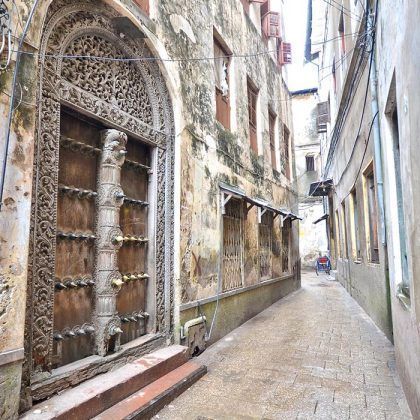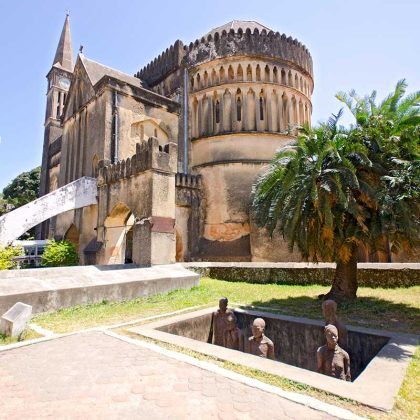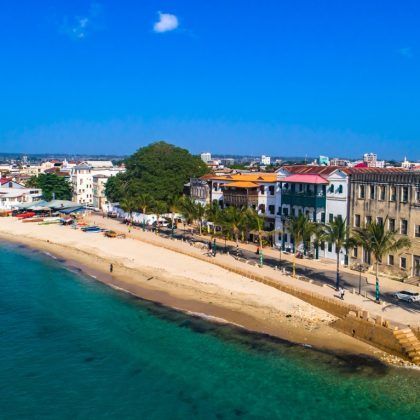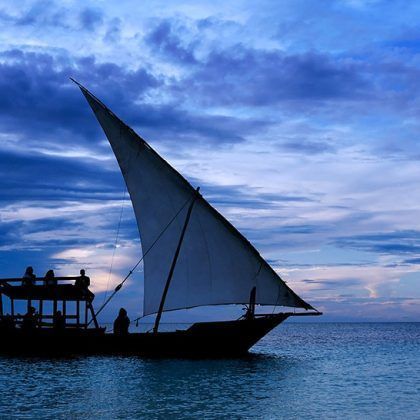Zanzibar has lured traders, adventurers, plunderers and explorers to its shores for centuries. The Assyrians, Sumerians, Egyptians, Phoenicians, Indians, Chinese, Persians, Portuguese, Omani Arabs, Dutch and English have all been here at one time or another. Some, particularly the Shirazi Persians and Omani Arabs, stayed to settle and rule. With this influence, Zanzibar has become predominantly Islamic (97%) – the remaining 3% is made up of Christians, Hindus and Sikhs. The earliest visitors to Zanzibar were Arab traders who are said to have arrived in the 8th century. The earliest building that remains on Zanzibar is the mosque at Kizimkazi, which dates from 1107, and is a present-day tourist attraction.
For centuries the Arabs sailed with the monsoon winds from Oman to trade primarily in ivory, slaves and spices. The two main islands, Unguja (normally known as Zanzibar Island) and Pemba, provided an ideal base for the Omani Arabs, being relatively small, and therefore fairly easy to defend. Indeed, in 1832, Sultan Seyyid Said, of the Busaid dynasty that had emerged in Oman, moved his Sultanate from Muscat to Zanzibar, perhaps making it easier to protect, where he and his descendants ruled for over 130 years. Most of the wealth lay in the hands of the Arab community, who were the main landowners at that time.
Zanzibar Stone Town
Widespread intermarriage between Shirazis and Africans gave rise to a coastal community with distinctive features, and a language derived in part from Arabic, which became known as Swahili. The name Swahili comes from the Arab word sawahil, which means ‘coast’. The Zanzibar descendants of this group were not greatly involved in the lucrative slave, spice and ivory trades. Instead, they immersed themselves mainly in agriculture and fishing. Those Shirazi that did not intermarry retained their identity as a separate group. Indian traders arrived in connection with the spice and ivory trade, and quickly settled as shopkeepers, traders, skilled artisans and professionals. The British became involved in missionary and trading activities in East Africa, and attempting to suppress the slave trade centred in Zanzibar.
Goods from Britain docked here before they moved on to other parts of Africa. No longer very prosperous in the fiscal sense, the island has a wealth of historical monuments to visit which commemorate the African, British and particularly Arab influences- sultan’s palaces, cathedrals, mosques, fortresses and old colonial houses. “Spice Tours” are the ideal way to see the island’s historic sites and spice plantations. There is also a sanctuary for the rare Zanzibar duiker and the red colobus monkey in the protected Jozani Forest, just twenty-five kilometers from the town.
Cultural aspects
The population of Zanzibar is predominantly Muslim with a rich Swahili culture. Because of religious and cultural traditions dress code is important, and men and women should dress appropriately when away from the beach, ie covering shoulders and legs too below the knees. Beachwear on the beach is fine, although nude or topless bathing is not tolerated.
When in villages or in Stone Town wearing beach wear would (and does) cause offence. Try to wear loose-fitting, non-transparent clothing when in public.
Zanzibari people are generally very warm, open and hospitable, and your respect for permission before taking photographs or filming local people is appreciated. Do not take photos or film at sensitive government sites including the State House, seaport, airport or military sites. If uncertain, it is always better to ask.
Public consumption of alcohol is not permissible, except in hotels and tourist areas, bars and some restaurants, where it is no problem.
Public displays of affection such as kissing are not customary and generally considered offensive, unless behind closed doors.
Local customs should respected. Mosques are sacred places an there is generally no entry to non-Muslims, unless accompanied by a person of the faith who can show you around except during the times for congregational prayer, which are five times daily.
When offering or accepting things, try and remember to offer and receive with your right hand. This is the hand which should also be used for eating.










